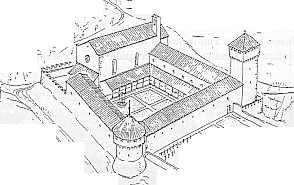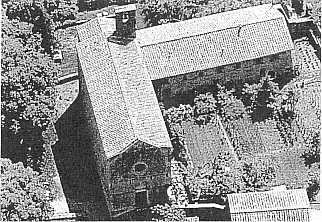Contenuto
Percorso : HOME > English > Pilgrims > MontecagnanoThe Hermitage of St. Leonard at the Lake

The old Hermitage of St. Leonard

The present Hermitage of St. Leonard
The Hermitage of St. Leonard at the Lakeá
San Leonardo is the oldest or the hermitages that precede the beginning or the beginning or the Augustinians. It can be dated back to no later than the year 1112 for which there exists a document attesting to the donation of land to the community by a certain Brunetto and his wife, Teodora. The founder of the hermitage is alleged to have been a man named Benedict whose presence guided it for many years. It was eventually called San Leonardo by the Lake because it was situated on a hillside by the edge of Lake Verano. In the nineteenth century, the lake was drained to avoid the contagion of malaria. However, the shape of the lake can still be seen in the farmland that is surrounded by a circle of low hills. San Leonardo has a mixed history.
From a hermitage, it was made a rural church with a community of Canons to serve the people. Then with the Little Union of 1244, it became a hermitage again. There is a record of the community being represented at the Order's General Chapter of 1250. A year later, it was placed under the community of Lecceto and there was one prior for both hermitages. Like Lecceto, the complex grew in size. A new church was built in 1350 and decorated by frescoes by Lippo Vanni around 1370.
In 1366, it was fortified with walls to protect it from bandits and marauding armies of the time. The most famous name connected with San Leonardo is that of Blessed Augustine Novello previously mentioned in connection with the foundation at Rosia. Augustine was one of the early Prior Generals of the Order, renowned for the part he played in composing its first Constitutions (Ratisbon 1290) and in leading the Order in the formative stage of its history. In 1300, he resigned his office and retired to San Leonardo to live witb the friars in contemplation until his deatb nine yearsálater. His body was buried in the Church of St. Augustine in Siena and his life was made famous by Simone Martini, one o Siena's most famous painters. At the end of the same century, the community became part of the Observant Congregation of Lecceto and remained a part of it for two hundred fifty years until 1516 when it joined the Province of Siena. Not long after that, the monastery was attacked by the imperial troops and was forced to surrender.
The rest of its years saw ups and downs. It was eventually suppressed by the same Grand Duke of Tuscany who closed Lecceto and it passed into the hands of a private family. Now, it belongs to the Italian government and is occupied by a caretaker who provides tours for visitors. San Leonardo also has an archeological interest. It is constructed on three levels of different epochs in history. The first level is visible to the eye in its medieval form. However, beneath the present Gothic church is another Romanesque one that dates back to at least 1124 and perhaps before that date. Underneath the monastery, there must be the ruins of the earliest hermitages. Still further beneath the Romanesque church is a cave which has provoked must speculation about its use since it lies directly under the two churches. The earliest manifestations of eremitical life in these parts of Tuscany were cave where a solitary ascetic lived in prayer and penance, eventually drawing other persons of similar intentions who together began a new community of hermits.
In the late nineteen seventies, the Augustinian Provinces of Villanova and Chicago, in collaboration with the Augustinian Historical Institute of Villanova University in Pennsylvania conducted excavations under the church and within the cloister to see if they could establish the history of Augustinian life here. Their work uncovered many details of the outline of the cloister and the fortified walls. In the middle of the cloister, fragments of pottery from around the year 1000 and an ancient cistern, most likelv used bv the friars to conserve water, were found. The cave, however, still remains a mystery. It has been wine cellar for over two hundred years and, according to some, always served that or another similar purpose. Others question whether or not it has something else to reveal. Notable parts of San Leonardo to recall are the church with its frescoes of St. Augustine and St. Monica, the cave, the Romanesque church, the ruins of the tower in the corner of the cloister, and the refectory with its fresco of the crucifixion.

